Our today’s test subject is one exceptionally quiet HD4870 with 2GB of memory coming from Sapphire, and it’s well worth noting that this is the first 2GB HD4870 on the market. It’s not a mystery that a lot of consumers rely on higher numbers alone when purchasing their cards, so we decided to test this card and see whether 2GB brings significant advantage over 1GB cards.
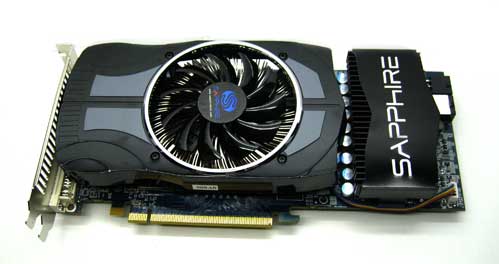
Radeon HD 4870 comes with GDDR5 memory, which was at the time this card launched, quite expensive and lacking in the availability department. Thankfully, AMD didn’t bow down and still ended up using GDDR5 but combined with a 256-bit memory interface. The first tests on HD 4870 were encouraging, as RV770 coupled with GDDR5 memory packed enough punch to beat its fierce competitor – the Geforce GTX 260. Nvidia of course, wouldn’t settle for second place, so they’ve increased the shader count and did some driver polishing in the meantime, which helped the GTX 260 to gain some ground over its rival.
GDDR5 memory, as you might already know, offers twice the bandwidth as GDDR3 if clocked the same. This means that 512-bit GDDR3 card packs the same bandwidth as the 256-bit GDDR5 card, provided the memory is identically clocked of course.
Compared to the GTX 260 where the 448-bit GDDR3 memory runs at 999MHz and offers a 111.9GB/s bandwidth, the HD 4870 with its 256-bit GDDR5 memory clocked at 900MHz offers a bandwidth of 115.2GB/s. This is due to GDDR5 speeds, and this memory runs at 3600MHz (4x900MHz) on the HD4870 whereas the GTX 260’s memory runs at 1998MHz (2x999MHz).
HD4870 launched with 512MB of memory, whereas the reference model with 1GB of memory followed. This has proven to be a wise move, as the card lost breath at higher resolutions. Additionally, games like Far Cry 2 have utilized additional memory quite well, something we expect to see in most upcoming hot titles. A 1GB video buffer however, is enough for most today’s gaming titles, so performance advantage when using 2GB memory is not as obvious as it is in the 512MB to 1GB jump.
Sapphire Vapor-X HD4870 2GB is the first HD4870 with 2GB of memory, and it boasts extremely quiet yet effective cooling solution. This is thanks to Vapor-X technology, which is Sapphire’s ace for a while now.
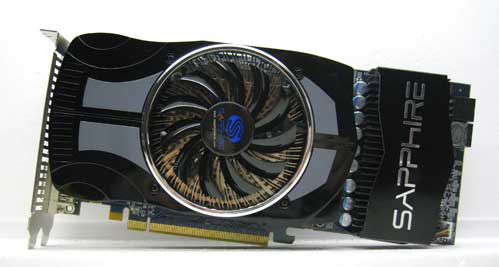
We see that Sapphire changed almost every aspect of the reference model, but the mighty Vapor-X cooling is something that will surely catch your eye first. This dual slot cooling looks quite massive, but taking off the hood reveals that it’s simple and quite small. The aluminum part resembles Intel’s reference CPU cooling, with the addition of Sapphire’s Vapor-X chamber on the bottom. Still, we’d always put silence before looks, and we must admit that on many occasions we wondered whether the fan is spinning at all, that’s how quiet it is.
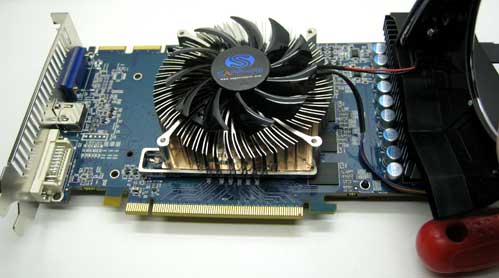
We’re no strangers to Vapor-X, as we’ve seen it and tested it on a couple of occasions, the last one being the HD4870 Toxic, here. The cooler ran like a charm with temperatures lower by up to 30°C compared to the reference model, which goes up to 89°C. Apart from the Vapor-X chamber, the aforementioned Toxic card uses three heatpipes. Our today’s card however, uses Vapor-X chamber with no heatpipe technology, but it still does a good job not letting the temperatures exceed 71°C. The fan rpm can be regulated, and thus increase the cooling efficiency with no worrying about high noise levels.
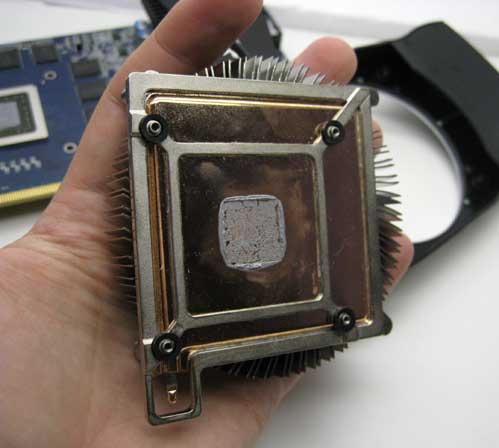
Vapor-X operates in a way similar to heatpipe technology, using water and vaporization to its advantage. The benefit of this flat design is allowing the vapor chamber to sit directly on the core.
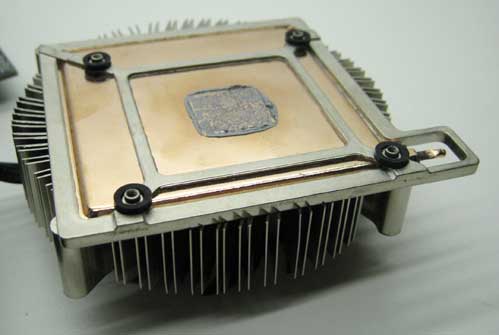
The heated water then turns to steam, in this case called vapor, and fills the vacuum chamber up. The air pressure within the chamber is extremely low, which enables for quick water-to-vapor transition. Important pieces of this puzzle are also the vaporization, condensation and transportation wicks. The GPU directly touches the vacuum chamber and acts as a heat-source for heating up the vaporization wick. The resulting vapor moves freely towards the cooler part of the chamber, where it turns to water upon touching the cold walls. The condensation wick then gathers the water and the transportation tampon takes it back to the vaporization wick and the process starts over again.
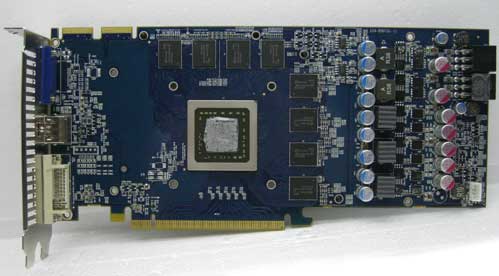
Sapphire changed the reference PCB and used all solid capacitors as well as “Diamond Black” heatsink chokes, which are more efficient and cooler than standard.
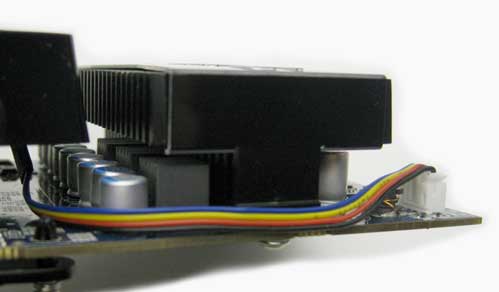
The back of the card houses a large passive heatsink, located above the power regulators. The PCB is painted blue, which is another proof that Sapphire team had their mitts all over this card. The card requires two 6-pin power cables to run, and you’ll find the connectors at the same spot as on the reference model.
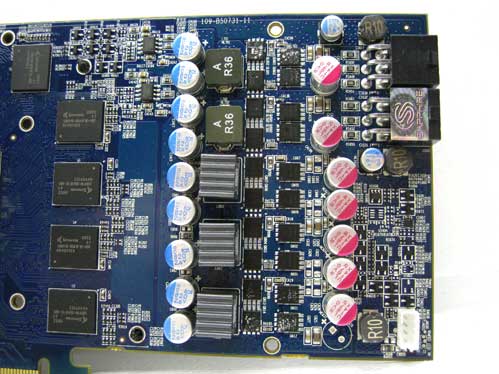
The memory is evenly distributed across both sides of the card. On the front it’s cooled by the fan, and on the back by the heatsink.
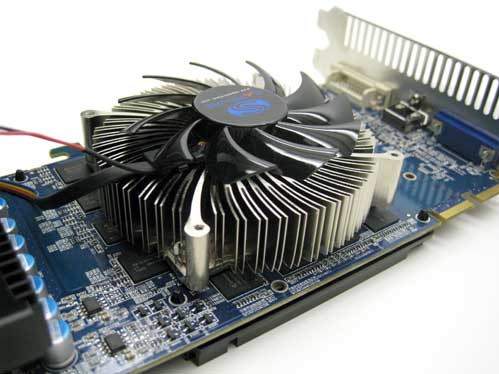
The memory in question is Qimonda IDGV1G-05A1F1C-40X rated at 1000MHz, but at this card it runs on reference 900MHz (3600MHz effectively).
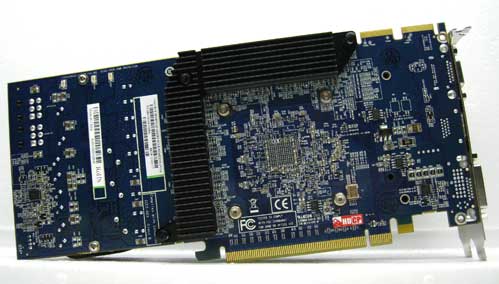
Although the cooler does a good job, Sapphire didn’t overclock the card so it still runs at 750MHz. This card is based on the famous RV770, packs almost a billion transistors and it’s built in 55nm. It packs 2.5 times more shaders and texture units compared to the HD 3800 generation and the rest of the important specs can be found on the GPU-Z screenshot.
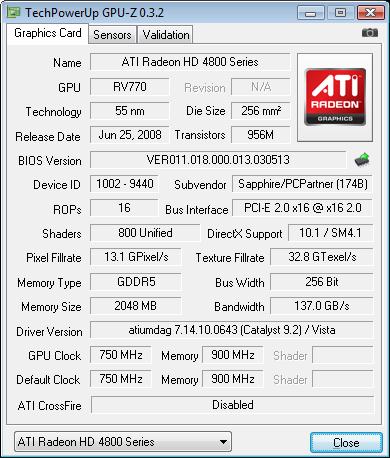
All the HD 4xxx cards feature 7.1 audio thanks to the Realtek’s HD Audio processor integrated into the GPU silicone. Unlike Nvidia’s offerings, there’s no need for connecting additional cables in order to bring both video and audio via one HDMi cable. Additionally, Sapphire’s Vapor-X card doesn’t need a DVI-to-HDMI dongle as the card features native HDMI connector. Next to it you’ll find one dual-link DVI and VGA out.
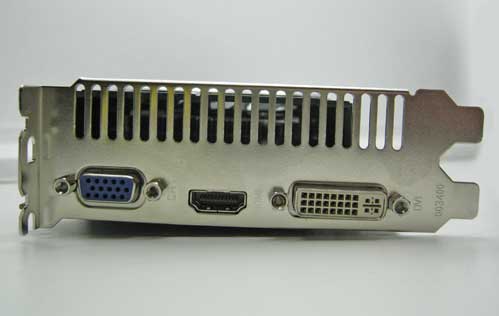
Sapphire’s packaging looks quite refreshing, and Vapor-X is of course is emphasized. You’ll also find other info such as 2GB of memory, native HDMI support and included software. We must admit that we always found Sapphire’s software offer to be the most complete, and this time you’ll get Cyberlink’s software package, Ruby Rom, 3DMark Vantage and of course – the driver CD.
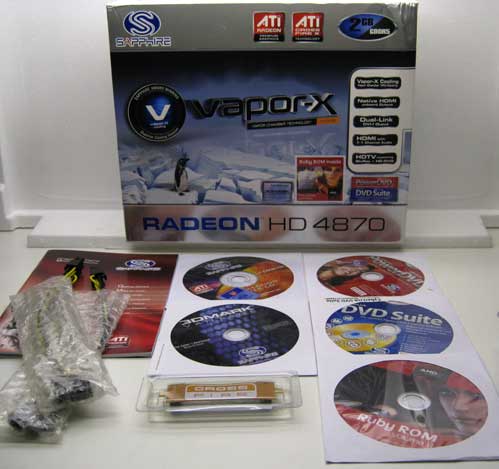
Benchmarking
TestBed
Motherboard: MSI P45D3 Platinum ( Provided by: MSI );
Processor: Intel Core 2 QX9770 Extreme edition at 3.6GHz ( Provided by: Intel );
Memory: Corsair Dominator 12800 7-7-7-24 ( Provided by: Corsair);
HDD: WD VelociRaptor 300G 10,000RPM ( Provided by: SmoothCreation );
Futuremark Tests
3DMark06 reports no performance advantage, quite the contrary; Vapor-X ends up being slower than the reference HD4870 with 1GB of memory, despite running at same clocks. After our overclock to 825MHz core and 1070MHz (4280MHz effectively) for the memory, Sapphire’s 2GB card swiftly outran its competition, including the Geforce GTX 260.
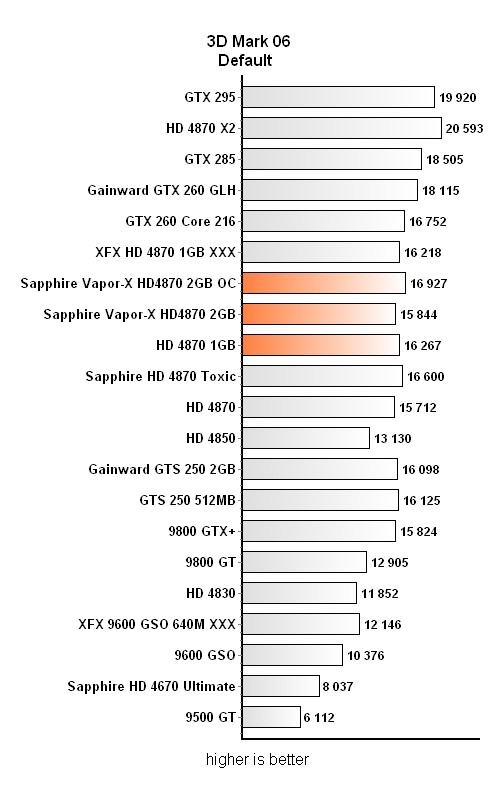
Futuremark synthetic tests don’t seem particularly fond of our today’s guest, as it ran slower than the reference HD4870 1GB card all the way up to the extreme settings. Overclocking brought the Vapor-X card some 6% to 8% better results. Note that the card was seriously quiet throughout our testing, and it’s one of the quietest, if not THE quietest, cards we’ve tested so far.
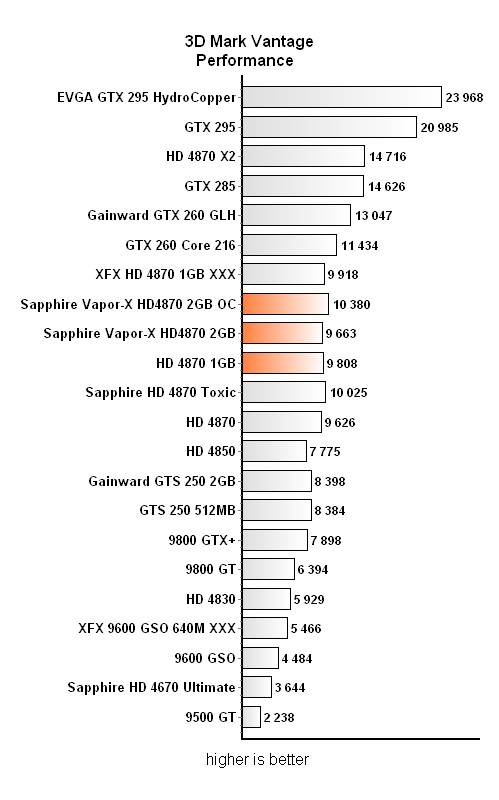
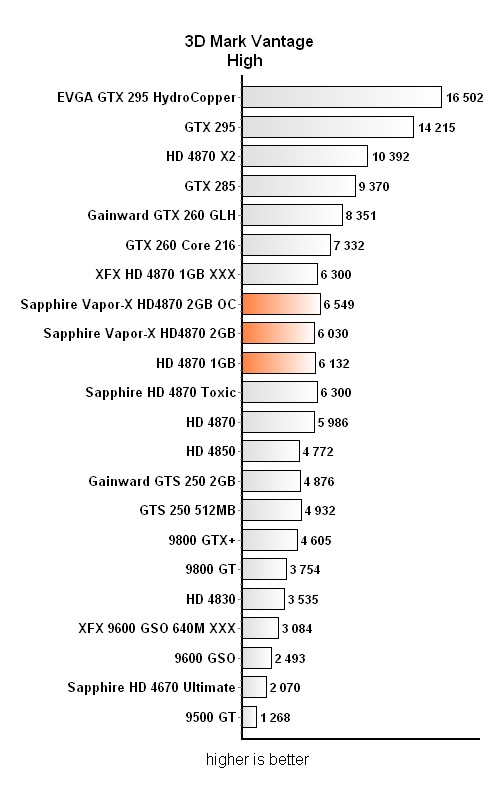
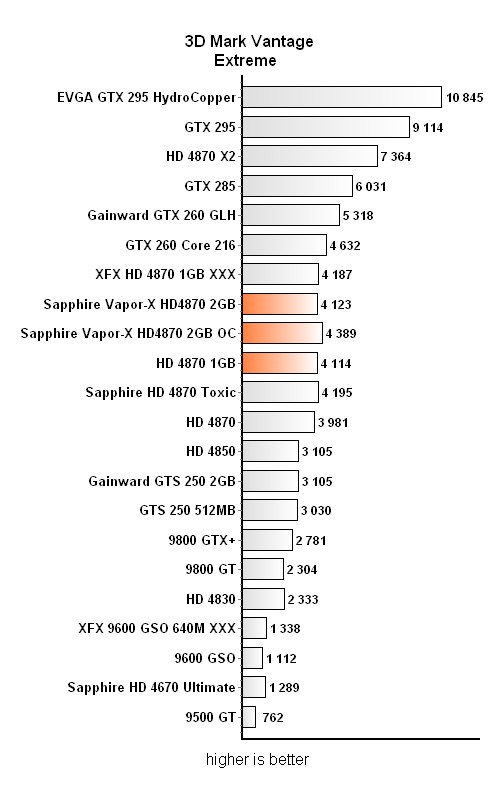
Game Testing
Far Cry 2
FarCry 2 is one of the games where HD4870 with 512MB and the same card with 1GB yield quite different results. Unfortunately, we can’t say the same for the 1GB and 2GB cards’ performance, as the performance difference is practically non-existent. We again resorted to overclocking, which improved results by up to 11%, and it was enough for 30fps at 2560x1600 AA and thankfully enough to beat the GTX 260.

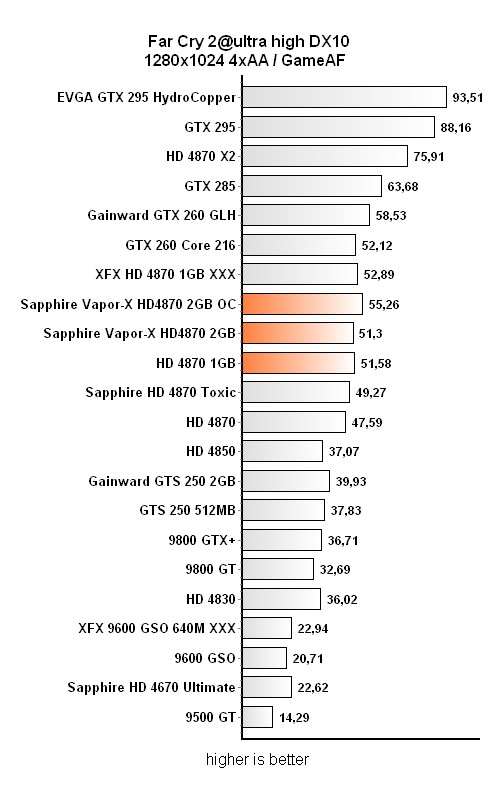
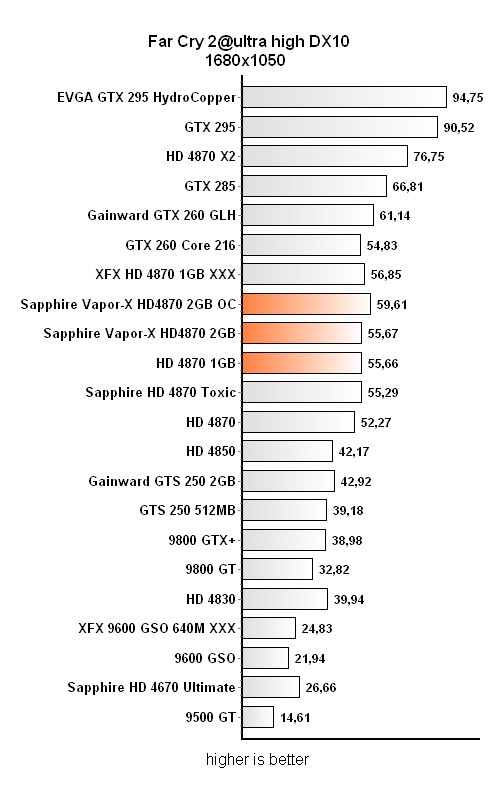
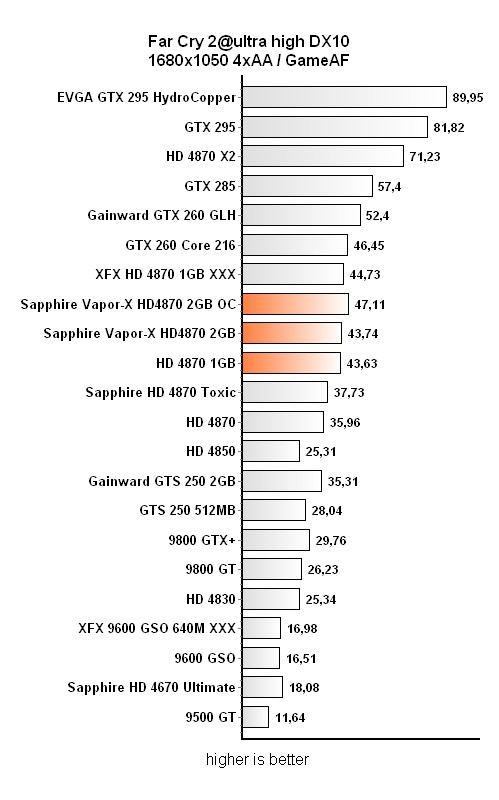
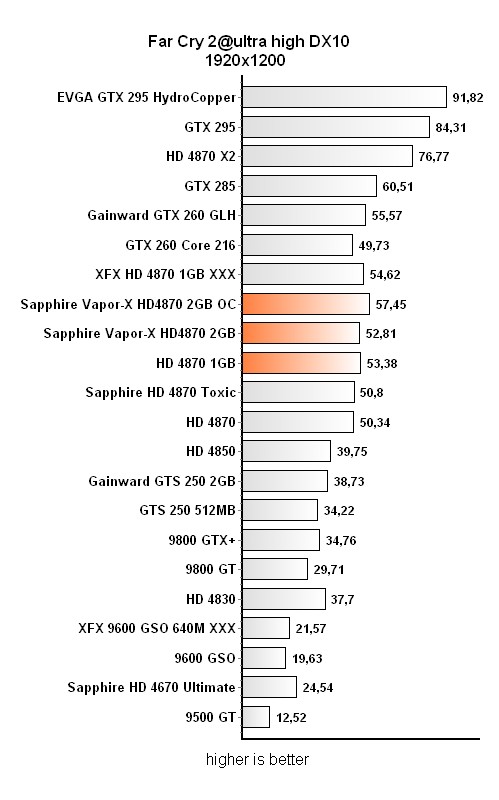
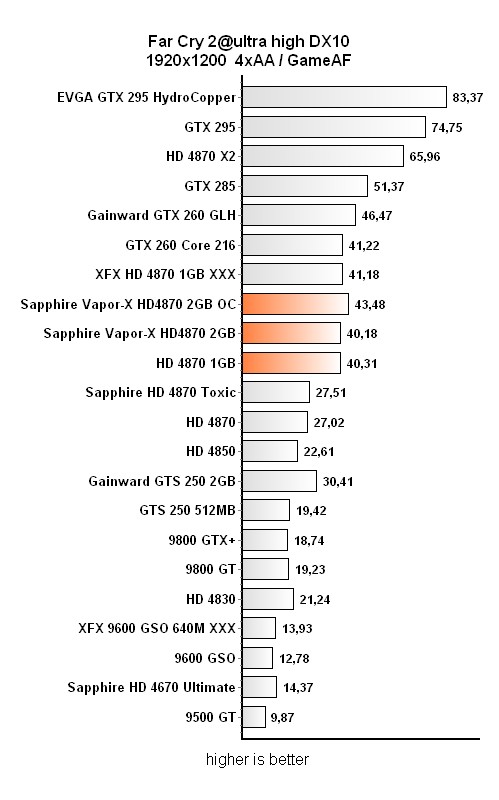
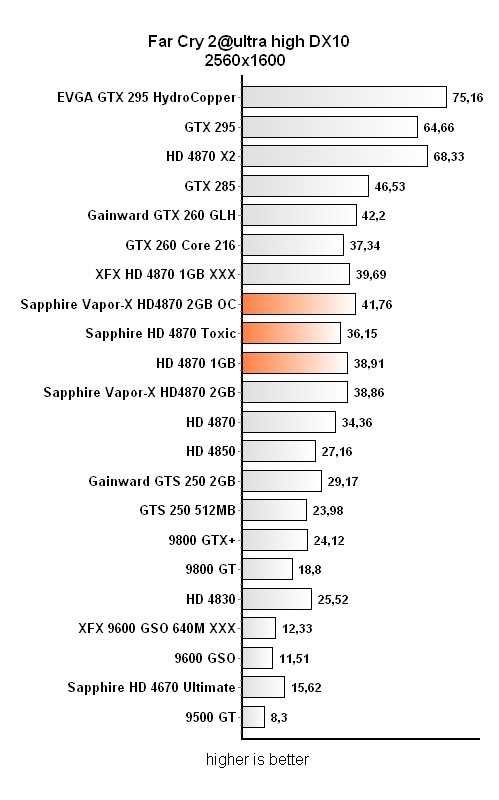
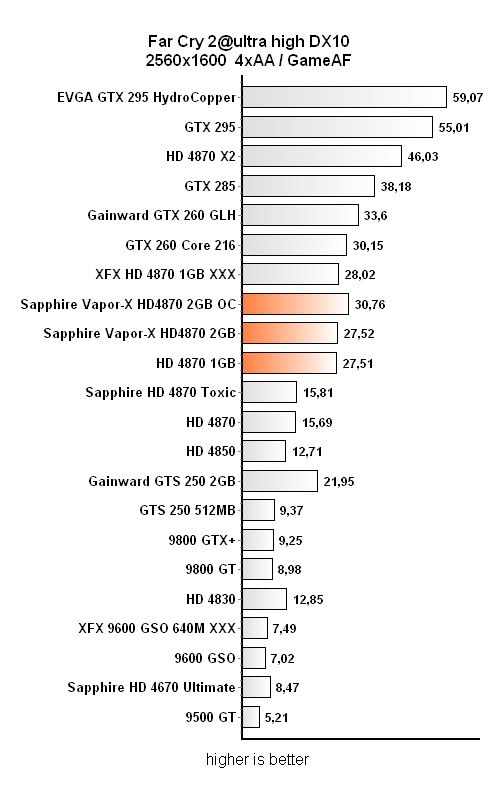
World in Conflict
World in Conflict is an older game and although it seems to like overclocking, it gives little importance to the size of the frame buffer. Vapor-X HD4870 2GB at reference speeds ran neck and neck with the reference HD4870 1GB, and the performance advantage was again visible after our overclocking.


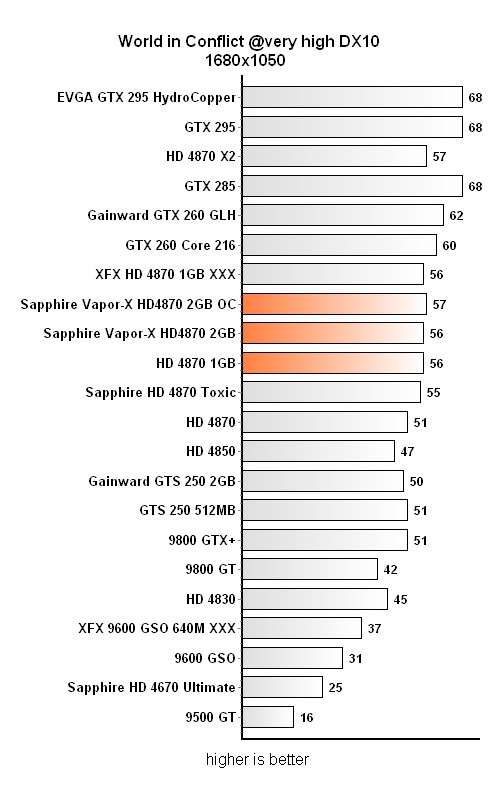

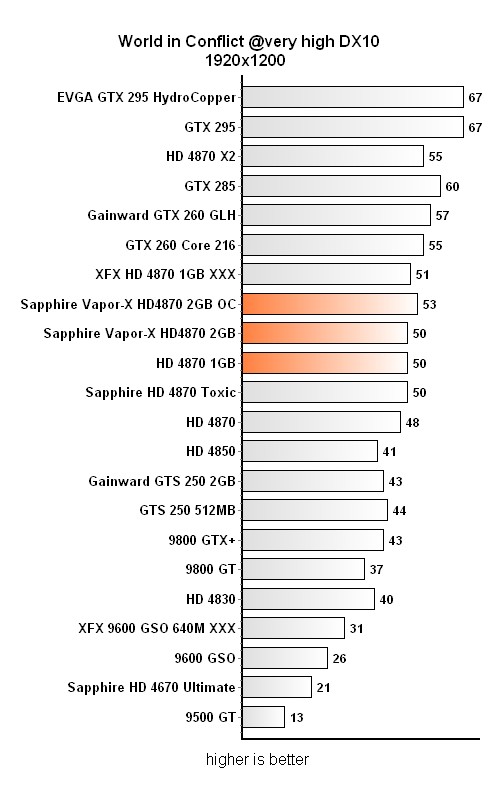
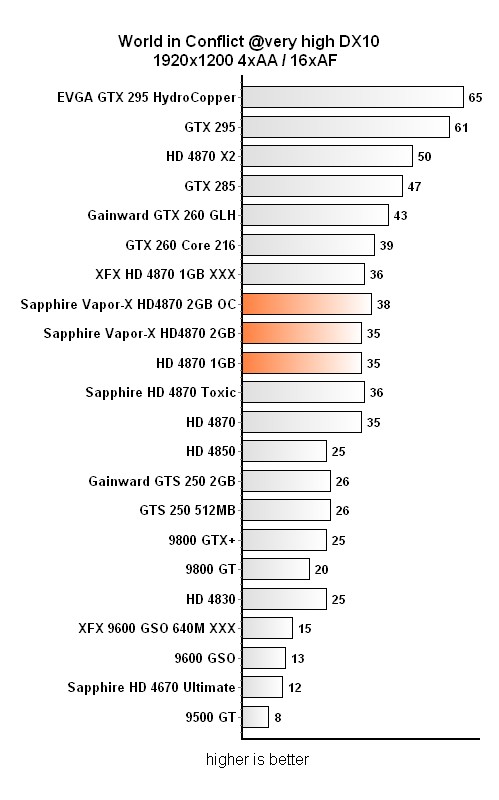
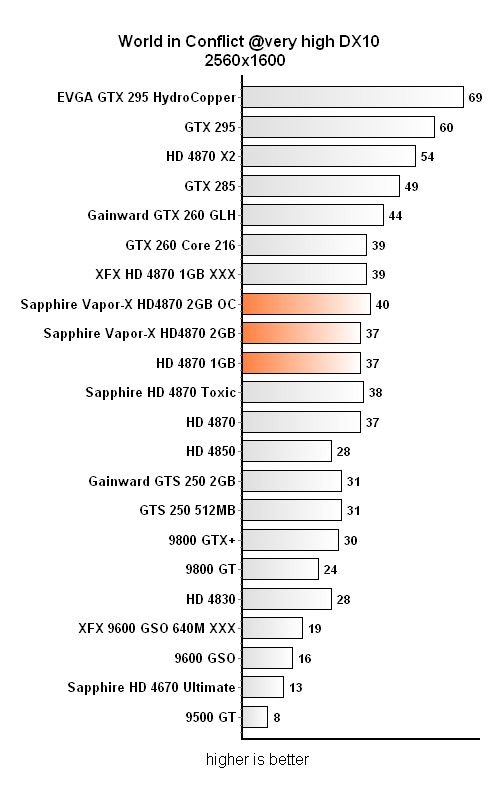
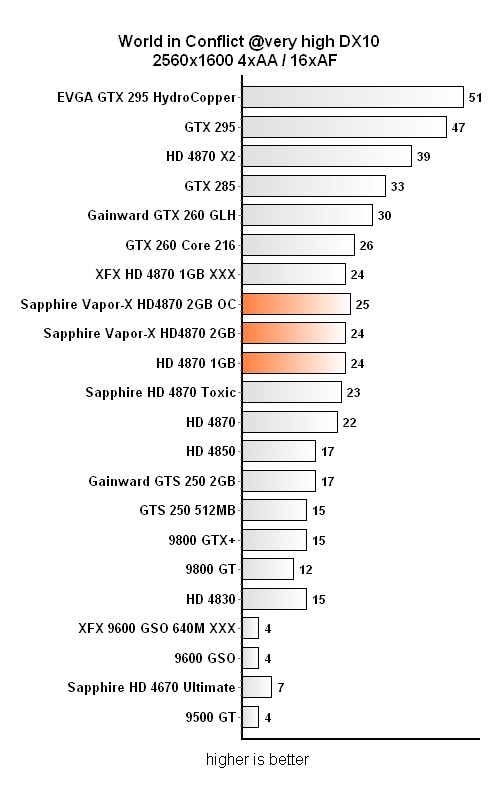
Left 4 Dead
Just like the previous two games, Left4Dead cared little about additional memory. It seems like speed is all that matters to this game as Sapphire Toxic HD4870 512 outran most of the HD4870 1GB cards.
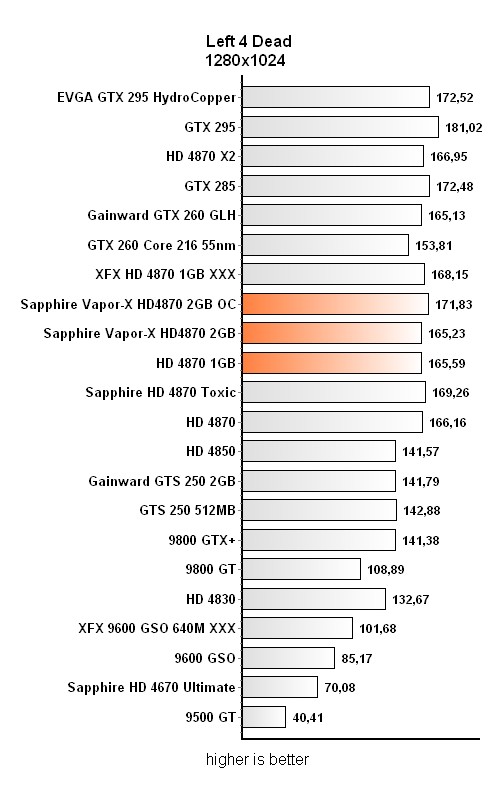
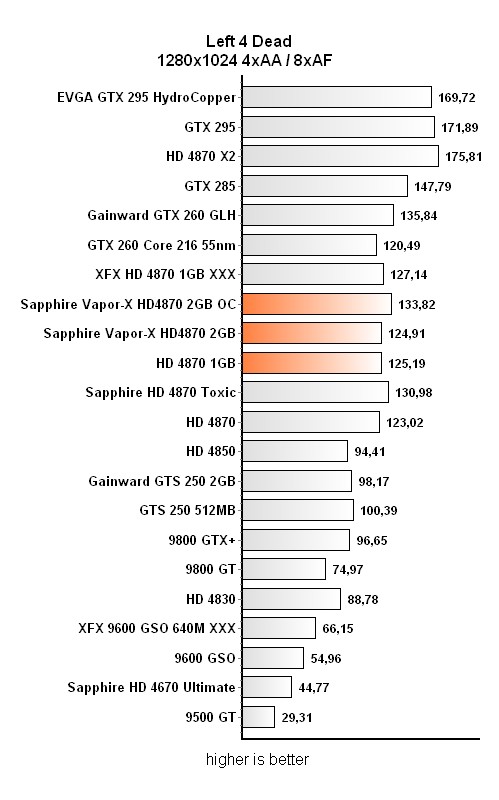
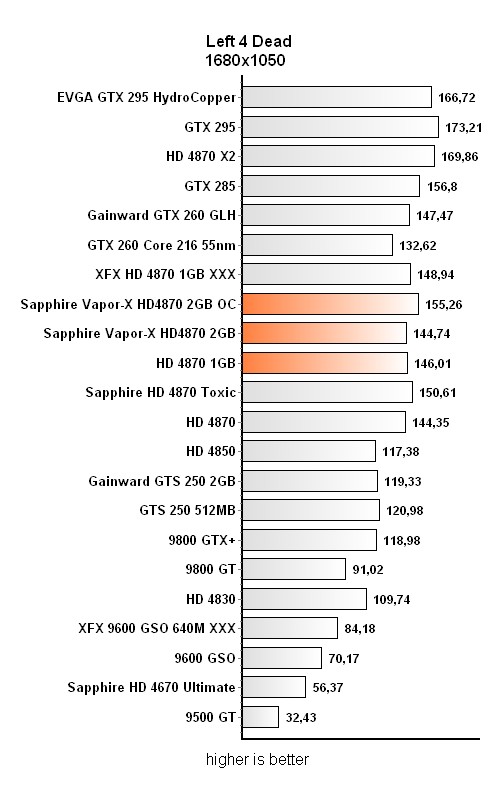
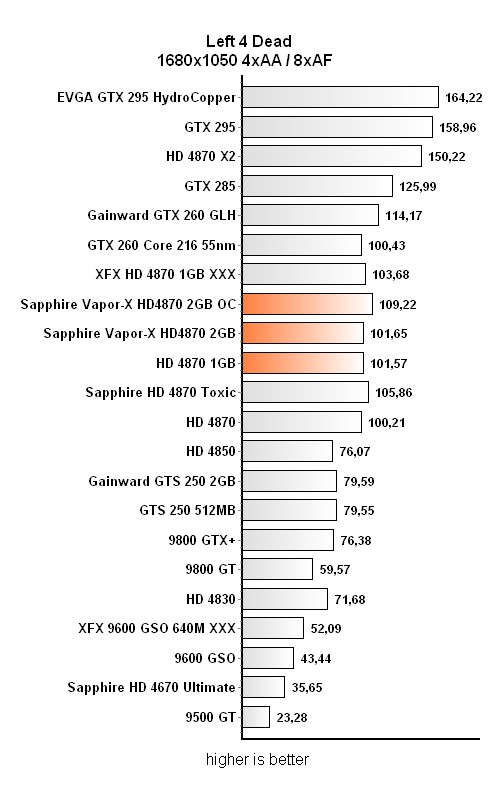
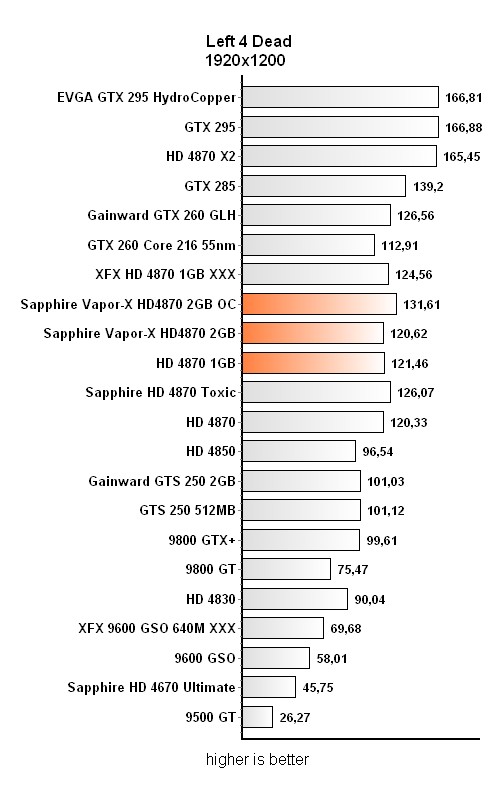
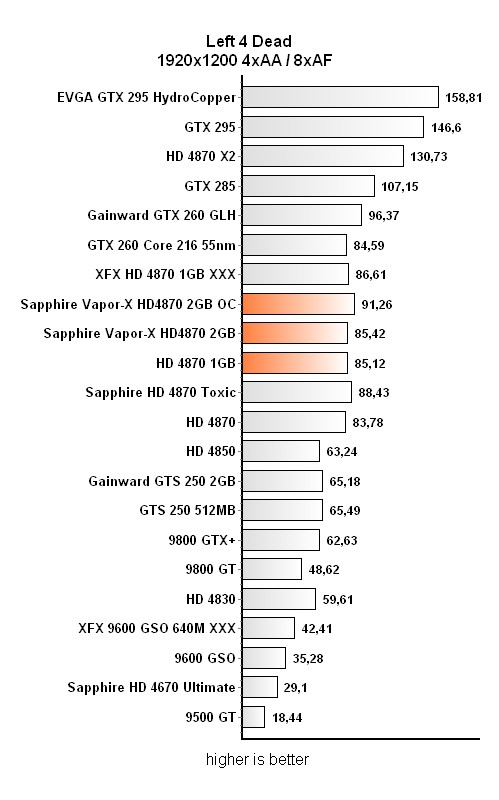
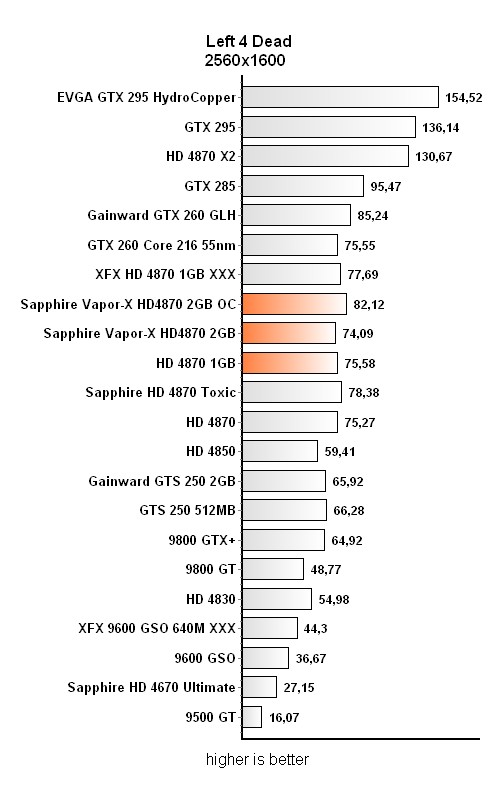
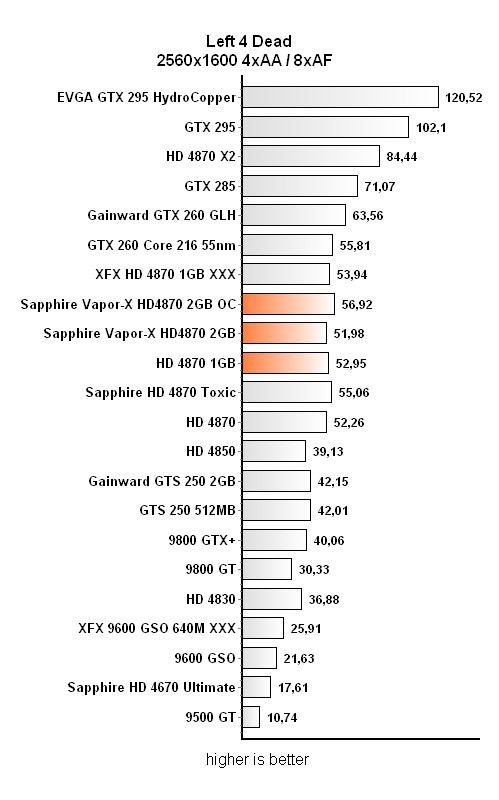
Overclocking
Overclocking Sapphire’s Vapor-X HD 4870 2GB card was similar to most other HD4870 cards we’ve tested so far. 825MHz core has proven stable together with memory at 1070MHz (4280MHz effectively). These 10% higher clocks resulted in more than 10% performance increase in certain tests, whereas the average performance boost amounted to about 8%.
Vapor-X cooling is really a gem, as our overclocking and not even setting the fan to run at maximum rpm couldn’t pierce the low noise levels this baby produces. Idle mode results in the card being completely inaudible, and we could almost say the same for 3D.
Maximum temperatures during operation were 71°C, but if you set the fan speed to 43% (still silent), the temperatures will duck to 64°C. At maximum rpm, the fan will lower the GPU temperatures to 53°C. In idle mode, the aforementioned three scenarios will result in as follows: auto fan mode 60°C, 43% fan speed at 46°C and maximum rpm at 39°C.
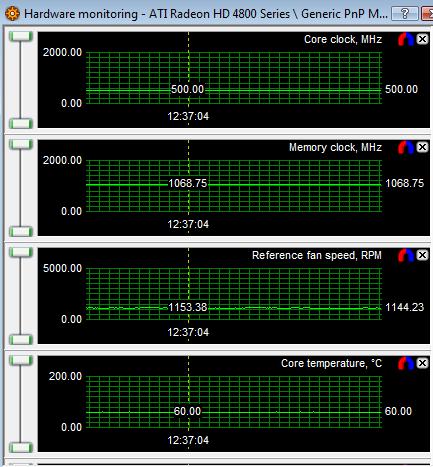
Idle
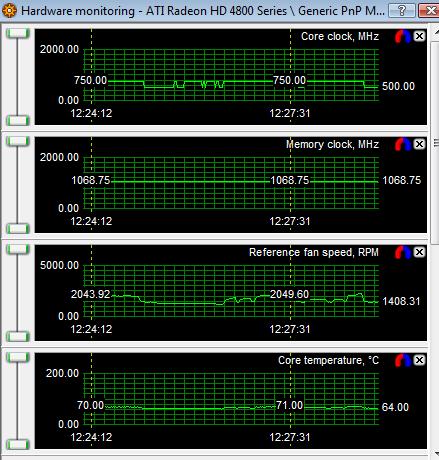
Load
Conclusion
Sapphire Vapor-X HD4870 2GB is the quietest HD4870 we’ve seen/heard so far. Vapor-X technology is truly a gem as it provides dead silence in 2D and not-so-dead but still silent 3D mode. This was one of the pros we’ve spotted on this card, but we can’t forget the HDMI out as well as 2GB of GDDR5 memory. Unfortunately, the additional memory didn’t do us much good in our today’s games and synthetic testing, but that doesn’t mean that there won’t be games that will benefit from 2GB of GDDR5 on this card.
Overclocking the Sapphire’s card is an easy and safe task as the cooling keeps the temperatures in check at all times and in all scenarios. During operation, the temperatures hit 70°C, which is much better compared to reference card’s 89°C.
If you crave a quality card that will enable gaming all the latest titles in complete silence, then you can’t afford to pass up on Sapphire’s Vapor-X HD 4870 2GB.

